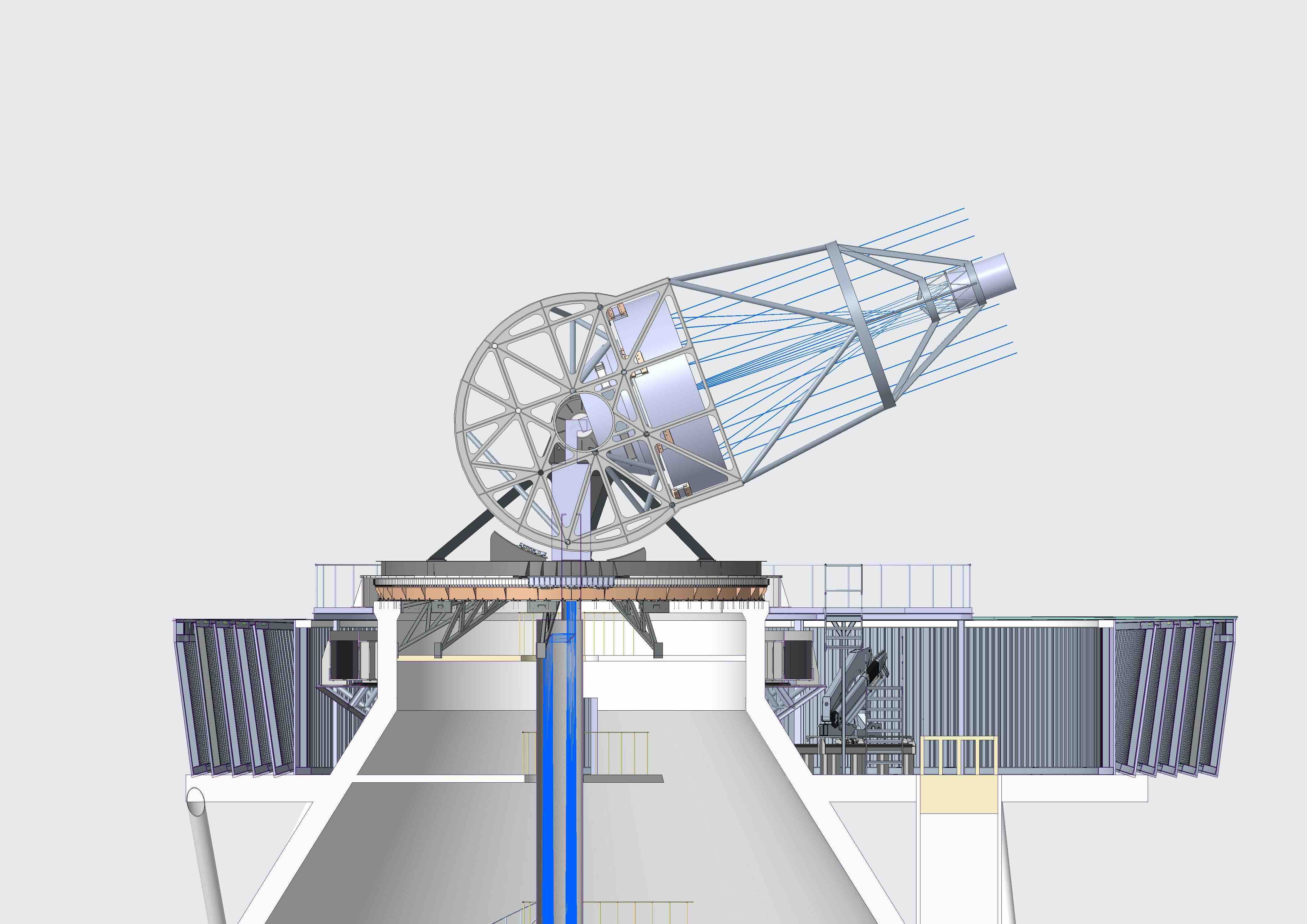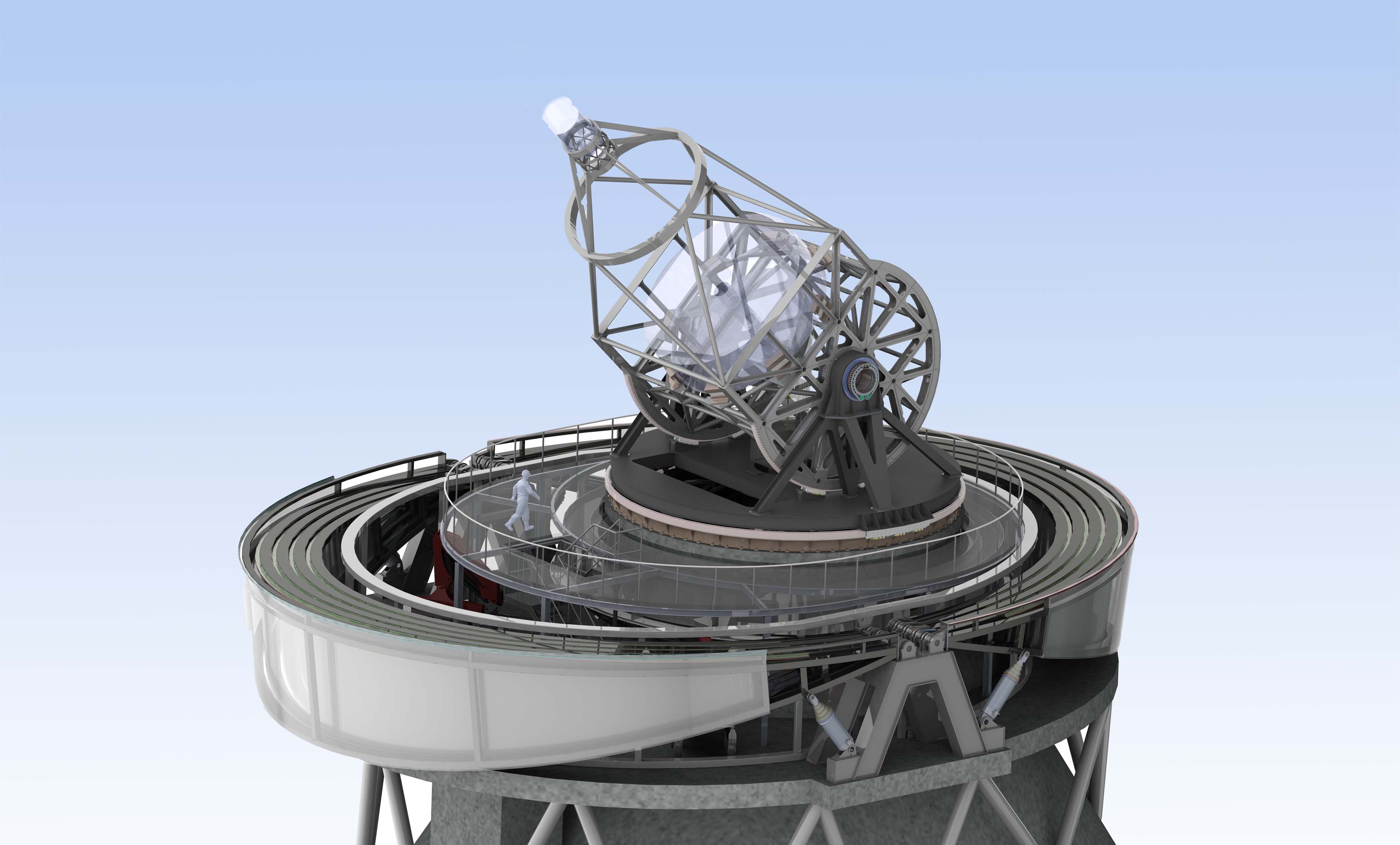Telescope Structure
The Telescope Structure enables the arrangement of optical elements within a simple and compact system, featuring improved airflow for the primary and secondary mirrors. This facilitates the attainment of a polarimetrically compensated optical design. The specific layout of the Telescope Structure is determined by the optical arrangement (see Figure 1).
The elevation axis has been positioned beneath the M1 vertex to facilitate natural air circulation to M1. This configuration also allows ample space for the M1 cell and ensures suitable positioning of the transfer optics train, extending vertically from the telescope to the Coudé focus where the instruments are located.

Figure 1. Diagram showing the EST telescope structure and light path from M1 to the pier's interior.
This atypical placement of the elevation axis below M1 results in a significant off-balanced weight around the elevation axis. However, this imbalance is counteracted by the underlying structure beneath M1. Furthermore, the azimuth and elevation axes are offset from the optical axis of the telescope due to the asymmetric folding of the optical path, which achieves a polarimetrically compensated layout.
The Telescope Structure adopts a gantry configuration featuring axial hydrostatic bearings and a central radial bearing on the azimuth axis, as well as rolling bearings on the elevation axis. The motion of both the elevation and azimuth axes is accomplished through direct drive motors. The structure offers substantial rigidity to minimise deflection of the optical unit and meet the required eigenfrequency.
The Elevation Structure supports the Secondary Mirror and Heat Rejecter using a lightweight spider, while the Primary Mirror is affixed to the Elevation Structure through eight mechanical interfaces. A sturdy trunnion is positioned at the centre of each lateral frame to accommodate two antifriction bearings. Additionally, two radial water-cooled direct drive motors are situated at the frames' periphery, delivering a position servosystem bandwidth of 8 Hz.
The elevation axis incorporates two compact and lightweight passive cable wraps, effectively reducing air obstruction through the telescope structure. Furthermore, the Elevation Structure includes a foldable textile cover to shield the system from undesired solar radiation, projected objects, and dust.
The Azimuth Structure directly transfers the vertical loads from the elevation axis to six axial hydrostatic bearings, ensuring high stiffness and low friction. The azimuth platform directs radial loads towards a central rolling bearing. The motion of the Azimuth Structure is facilitated by two direct drives.
The Telescope Structure achieves a pointing error of 2.28 arcsec (as opposed to the required 2.70 arcsec) and a tracking error of 0.76 arcsec (compared to the necessary 0.90 arcsec). This correction addresses various sources of error, including gravity, manufacturing errors, assembly errors, thermal discrepancies, wind effects, guiding accuracy, and vibrations. This correction is achieved without utilising feedback from the acquisition and guiding system.
To ensure constant movement to the parking position of the Telescope Structure, redundant systems have been integrated into the drive systems. In the elevation axis, an auxiliary system for elevation incorporates the actuator, a fail-safe brake, and the locking pin system in a compact design. In the azimuth axis, an auxiliary guiding system is devised for each hydrostatic pad, featuring a PTFE (polytetrafluoroethylene) wheel hydraulically operated through an external/manual pumping system.
The thermal control applied to the Telescope Structure primarily comprises passive solutions, including enhanced natural airflow and the application of high-reflective coating (white colour). In more stringent scenarios, the inclusion of plate coils will be implemented to meet the ±1°C specification in comparison to the ambient air temperature.

Figure 2. Render of the EST telescope structure with the primary and secondary mirrors.
